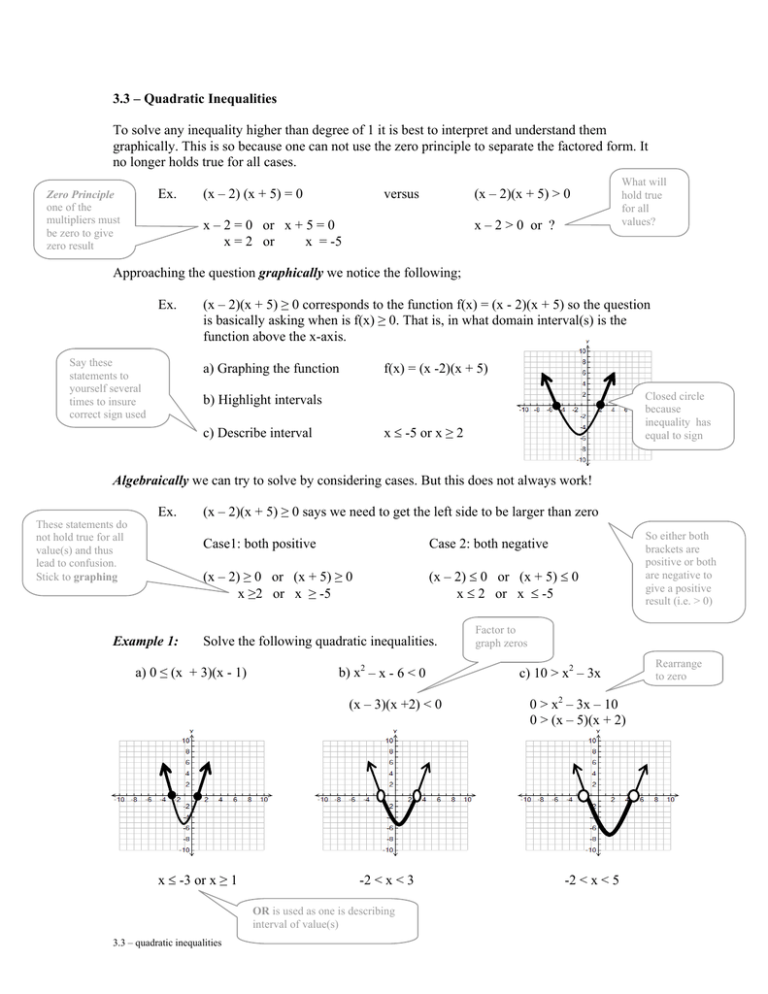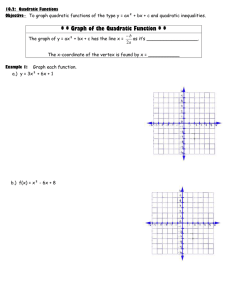3.3 – Quadratic Inequalities
advertisement

3.3 – Quadratic Inequalities To solve any inequality higher than degree of 1 it is best to interpret and understand them graphically. This is so because one can not use the zero principle to separate the factored form. It no longer holds true for all cases. Ex. Zero Principle one of the multipliers must be zero to give zero result (x – 2) (x + 5) = 0 versus (x – 2)(x + 5) > 0 x – 2 = 0 or x + 5 = 0 x = 2 or x = -5 x – 2 > 0 or ? What will hold true for all values? Approaching the question graphically we notice the following; Ex. Say these statements to yourself several times to insure correct sign used (x – 2)(x + 5) ≥ 0 corresponds to the function f(x) = (x - 2)(x + 5) so the question is basically asking when is f(x) ≥ 0. That is, in what domain interval(s) is the function above the x-axis. a) Graphing the function f(x) = (x -2)(x + 5) Closed circle because inequality has equal to sign b) Highlight intervals x ≤ -5 or x ≥ 2 c) Describe interval Algebraically we can try to solve by considering cases. But this does not always work! These statements do not hold true for all value(s) and thus lead to confusion. Stick to graphing Ex. Example 1: (x – 2)(x + 5) ≥ 0 says we need to get the left side to be larger than zero Case1: both positive Case 2: both negative (x – 2) ≥ 0 or (x + 5) ≥ 0 x ≥2 or x ≥ -5 (x – 2) ≤ 0 or (x + 5) ≤ 0 x ≤ 2 or x ≤ -5 Solve the following quadratic inequalities. a) 0 ≤ (x + 3)(x - 1) b) x2 – x - 6 < 0 (x – 3)(x +2) < 0 x ≤ -3 or x ≥ 1 -2 < x < 3 OR is used as one is describing interval of value(s) 3.3 – quadratic inequalities So either both brackets are positive or both are negative to give a positive result (i.e. > 0) Factor to graph zeros c) 10 > x2 – 3x 0 > x2 – 3x – 10 0 > (x – 5)(x + 2) -2 < x < 5 Rearrange to zero 3.3 – Quadratic Inequalities Practice Questions 1. Use graphs below to describe when f(x) > 0. a) b) c) 2. Use graphs from questions #1 to describe when f(x) ≤ 0. 3. Solve the following quadratic inequality by graphing. a) (x – 1)(x + 4) < 0 d) 10 < x2 + 3x g) 10x ≥ 25 + x2 j) (a – 2)2 + 3 < 0 b) 0 ≥ -(x + 3)(x - 1) e) y2 > 9 h) 2x(x – 1) < x2 + 3 k) m - 2 ≤ -6m2 c) -x2 –5x - 6 < 0 f) m2 – 2m – 24 ≤ 0 i) 5x2 ≤ x + 18 l) 2x2 > 5x 4. A ball thrown in the has its height, in meters, described by the function h(t) = -5t2 + 20t + 2, where time is measured in seconds. Determine to the nearest tenth for how long the ball is above 17m high. Answers 1. a) x<-5 or x>1 b) x≠3 or x < 3,3<x c) -8 < x < -2 2. a) -5 ≤ x ≤ 1 b) x=3 c) x ≤ -8 or x ≥ -2 3. a) -4<x<1 b) x ≤ -3 or x ≥1 c) x < -3 or x > -2 d) x < -5 or x > 2 e) y < -3 or y >3 f) -4 ≤ m ≤ 6 g) x=5 h) -1 < x < 3 i) -1.8 ≤ x ≤ 2 j) no solution k) -2/3 ≤ m ≤ 1/2 l) x<0 or x>2.5 4. 2 seconds 3.3 – quadratic inequalities 3.3 - Sketching Practice Sheets 3.3 – quadratic inequalities

